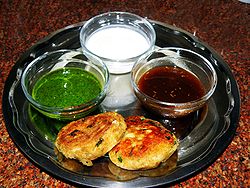This article needs additional citations for verification .(February 2013) |
 Aloo tikki served with mint and tamarind sauces and yogurt | |
| Alternative names | Aloo ki tikkia Aloo ki tikki |
|---|---|
| Type | Snack |
| Place of origin | Indian subcontinent |
| Region or state | India, Bangladesh, and Pakistan |
| Serving temperature | Hot |
| Main ingredients | Potatoes, peas, spices, herbs |
| Variations | Ragda pattice |
Aloo tikki, also known as aloo ki tikkia, aloo ki tikki or alu tikki, is a vegetarian snack originating from the Indian subcontinent. [1] In Indian, Pakistani, and Bangladeshi preparation, it is made of boiled potatoes, peas, and various Indian spices. Aloo means potato in Hindi-Urdu, and tikki is a small cutlet or croquette. The dish is served hot along with a side of saunth, tamarind, and coriander-mint sauce, and sometimes dahi (yogurt) or chickpeas. [2]

